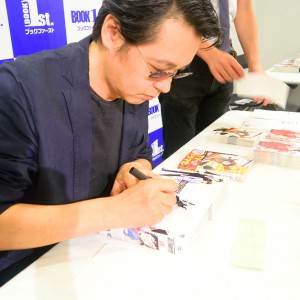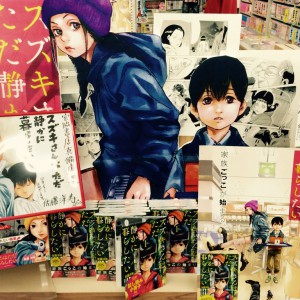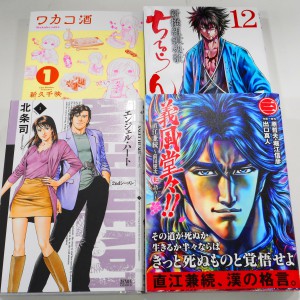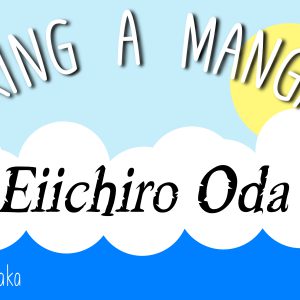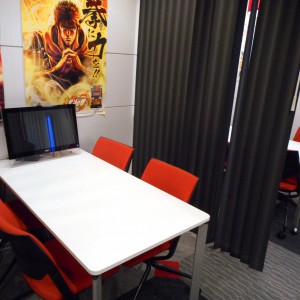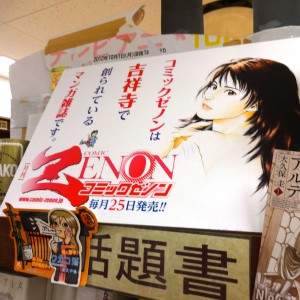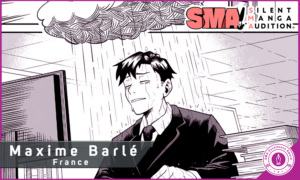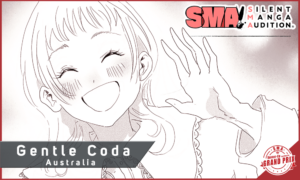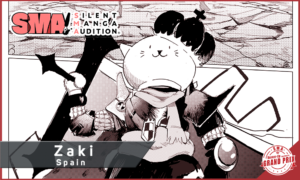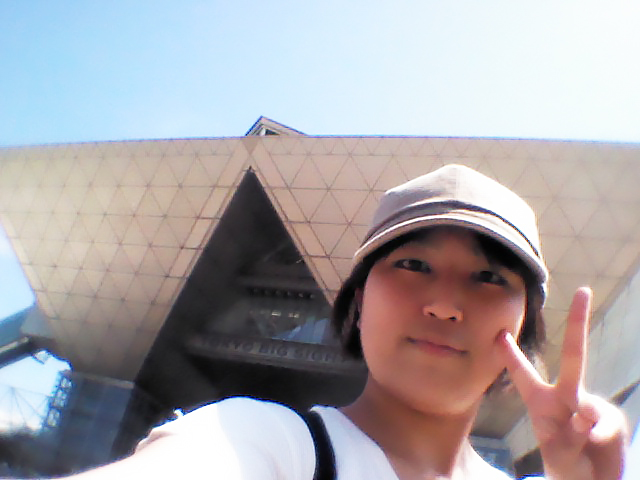

Me, in front of the Tokyo Big Sight!
1. Comiket Preparations: The Planning Stage
Preparations for Comike begin roughly one month in advance. The first step is to buy the official catalog. Most bookstores in Japan will carry them in the period leading up to the event. There’s a book version and a DVD version of the catalog. The books cost about 2000-2500 yen (the price varies depending on whether you buy it directly or from a bookstore) and the DVDs are all 2500 yen. The cover of the 88th Comike catalog featured Kaoru Shintani-sensei’s “Area 88”! Just look how thick it is!
Just look how thick it is!
 The Comiket catalog begins with an explanation of “What is Comiket?” and also includes things like rules, personal stories and adverts. Most importantly, there’s a list of where all the circles will display their wares. Not only is it fun to read, but in a pinch, this convenient book can turn into both your weapon and your Armour.
If you attend Comiket, this catalog is a “must-have” item.
After reading through this book, the next step is deciding which circles you would like to visit.
The Comiket catalog begins with an explanation of “What is Comiket?” and also includes things like rules, personal stories and adverts. Most importantly, there’s a list of where all the circles will display their wares. Not only is it fun to read, but in a pinch, this convenient book can turn into both your weapon and your Armour.
If you attend Comiket, this catalog is a “must-have” item.
After reading through this book, the next step is deciding which circles you would like to visit.

A map of the entire building. You’re sure to get lost if you don’t have a copy of this map!

Some introduction from the committee. It’s a long article, but you can feel the passion and love they give to Comiket!
2. Comiket Preparations: What to Bring and Wear
Since I decided to go first thing in the morning, my Comiket preparations started one week in advance. There’s a Japanese proverb that says “Sonae areba, Urei nashi” (Roughly translated: Good preparation means no worries). If you prepare for all possible outcomes, then even a “battlefield” is survivable! This is what I prepared for Summer Comike:– A knapsack to carry all my tools (Thus leaving my hands free) – A tote bag for my “spoils of war” – A hat – A raincoat (Umbrellas are dangerous in large crowds since you might poke someone in the eye. Therefore, they’re not allowed.) – An instant Zabuton (A kind of floor cushion.) – 1.5 liters of drink (Both room temperature and cold drinks.) – 2 towels (To use as sunshade and to wipe away sweat.) – A clear file (For flyers and the map.) – Cash (In small convenient denominations.) – Suica Card (An electronic pass card used for public transport… fully charged of course.) – First aid kit, health insurance card and ID (If worst comes to worst) – Cellphone charger (I use my phone a lot and the battery runs out fast!) – Games and manga to kill time – Tissues – A plastic bag (To throw away rubbish.) – Shioame 200g (A kind of sweet.) – Onigiri (A light snack, so that I don’t collapse from lack of food.) – Cooling gel sheets and sheets for wiping sweat
If you’re interested in cosplay, then you might want to add a camera to that list. Not only was this a hot summertime event, but the weather in Japan has been warmer than usual this year, so I took every possible precaution. For the Winter Comike, you’d substitute the cooling gel sheets and towels with body warmers and gloves to stave off the cold. One more thing: You need to choose your clothing carefully! You need something that’s easy to move in, and will stay comfortable even if you swet sweat. The venue is huge. And there are loads of people. It’s an event where you need to be able to move freely. This isn’t just a matter of warmth and fashion, you need to think of mobility as well. And in the case of ladies, you really need to be careful about what shoes you pick. Shoes with low heels that are easy to move in are best. If possible, sneakers. This is essential to enjoying Comiket. When you’re stuck in the middle of crowd, it’s quite possible that you’ll stamp on someone’s foot, or get your own foot stamped on. In this case, sandals and boots could lead to injury, so sneakers are said to be the best choice. If you prepare all of this, then you shouldn’t have any problems on the day. The rest is just waiting…3. Off to the Venue!
Finally, the long-awaited day arrives! I want to enjoy it to the fullest! To make sure that I’m in your best condition when I face the battlefield, I made sure to get plenty of food and sleep the night before.
 I caught the first bus at 5:30 in the morning, and then switched to a train. I arrived at Kokusaitenjijou (literally “International Exhibition Area”), the venue for Comike, at 7:00 am.
I caught the first bus at 5:30 in the morning, and then switched to a train. I arrived at Kokusaitenjijou (literally “International Exhibition Area”), the venue for Comike, at 7:00 am.
 Despite it being so early, a huge crowd of people had already gathered!
This dense line continues for several hundred meters.
People started lining up at about 5:00 in the morning, and a mere 2 hours later, it had reached this length. How long will it be by the time the gates open?
Anyway, if you don’t get in line, you can’t start move forward! So let’s head to the back…
Despite it being so early, a huge crowd of people had already gathered!
This dense line continues for several hundred meters.
People started lining up at about 5:00 in the morning, and a mere 2 hours later, it had reached this length. How long will it be by the time the gates open?
Anyway, if you don’t get in line, you can’t start move forward! So let’s head to the back…
 The Kokusaitenjijou where Comike is held has both an East Hall and a West Hall. There are separate queues to get into each, so it’s best to confirm the location of the booths you want to go to before you begin. Lining up in the wrong place could cost you a lot of time!
On the way, you often see staff wearing special uniforms. They’re all volunteers who help to keep Comiket running smoothly. Managing 500,000 visitors is no small task, and the Comiket management volunteers are well known for their efficient leadership. If not for them, these queues might be even more convoluted…
Thankful for all their hard work, I headed to the back of the line. Until the gates open, all one can do is wait… just wait…
The Kokusaitenjijou where Comike is held has both an East Hall and a West Hall. There are separate queues to get into each, so it’s best to confirm the location of the booths you want to go to before you begin. Lining up in the wrong place could cost you a lot of time!
On the way, you often see staff wearing special uniforms. They’re all volunteers who help to keep Comiket running smoothly. Managing 500,000 visitors is no small task, and the Comiket management volunteers are well known for their efficient leadership. If not for them, these queues might be even more convoluted…
Thankful for all their hard work, I headed to the back of the line. Until the gates open, all one can do is wait… just wait…

Photo taken on Comiket Day 2, at the East hall entrance. The lining was really well organized!!

This is only about 1/5 of the entire line, just for the east hall!! Can you believe it!?
– During the event, you’ll need to line for the toilet as well. Lining up and doing your business can take half an hour, even for the guys. So it’s best to do your business beforehand. There are several toilets but all of them are extremely crowded, so be sure to line up before it gets urgent. If you start leaking then it’s too late! – Comiket takes place in the middle of summer, and the middle of winter. In summer, the scorching sun beats down on you, and in winter, you’re battered with freezing winds. In either case, conditions are harsh. That’s why it’s important to monitor your physical condition, and not push yourself too hard. If you feel sick, tell the nearest staff member. Remember, even those valuable manga goods aren’t worth your life! – You’re not allowed to use an umbrella! It not only takes up space, but you might poke someone in the eye, and the water runoff from your umbrella might fall on someone else. So for rainy days, bring a raincoat. For sunny days, use sunscreen and a hat. Towels are also unexpectedly useful! (Some of the people in the photo are using umbrellas but it’s actually not allowed!)
4. Shopping!
10 ‘o clock sharp. Urged on by the voices of the staff, the great gates open, and the long snaking line of visitors are absorbed into the building. I got in at some point between ten-thirty and eleven. Right, this is where the true “battle” begins!
Entering the battle zone…
 At my destination, I found yet another line. The final person was holding a sign that said “The end of the line is here”. If you want to line up, you just take the sign from them. With this system, there’s no need to assign staff, but everyone knows where to line up. And when another person arrives, you can pass the sign onto them. This spirit of co-operation is part of the fun of Comike.
If you visit a wall circle, or a company-run circle, it’s almost guaranteed that you’ll have to line up, even when you’re already inside the venue. And the more popular the circle, the longer the line. I stood in line for a whole hour and a half! When I joined the line, it was already running out of the building. You’re not allowed to sit down, since you would get in the way of other visitors, so you have to stand the whole time. Moving forward inch by inch under the burning sun is physically draining… it’s time like this that you’ll be grateful for the preparations that you made.
I was lucky enough to be able to buy the book I was aiming for, but apparently they sold out a mere 5 minutes later! Sometimes people wait in line for an hour or two, but can’t buy the thing they want… that’s one of the hardest parts of Comike.
At my destination, I found yet another line. The final person was holding a sign that said “The end of the line is here”. If you want to line up, you just take the sign from them. With this system, there’s no need to assign staff, but everyone knows where to line up. And when another person arrives, you can pass the sign onto them. This spirit of co-operation is part of the fun of Comike.
If you visit a wall circle, or a company-run circle, it’s almost guaranteed that you’ll have to line up, even when you’re already inside the venue. And the more popular the circle, the longer the line. I stood in line for a whole hour and a half! When I joined the line, it was already running out of the building. You’re not allowed to sit down, since you would get in the way of other visitors, so you have to stand the whole time. Moving forward inch by inch under the burning sun is physically draining… it’s time like this that you’ll be grateful for the preparations that you made.
I was lucky enough to be able to buy the book I was aiming for, but apparently they sold out a mere 5 minutes later! Sometimes people wait in line for an hour or two, but can’t buy the thing they want… that’s one of the hardest parts of Comike.
 Of course, we don’t go to Comike just to line up for wall circles! It’s also fun to wander around the island circles, and browse their books. There’s nothing as wonderful as discovering a wonderful new book that you didn’t notice when you were going through the circle list.
After finishing my shopping, I ended up leaving the venue at about 1 ‘o clock. In just 3 and a half hours, I had collected a great many spoils of war!
I spent about 25000 yen (about 200 dollars). Doujinshi’s usually sell for under 1000 yen, but the goods from company-run circles are a little more pricy, so my expenses went up.
Of course, we don’t go to Comike just to line up for wall circles! It’s also fun to wander around the island circles, and browse their books. There’s nothing as wonderful as discovering a wonderful new book that you didn’t notice when you were going through the circle list.
After finishing my shopping, I ended up leaving the venue at about 1 ‘o clock. In just 3 and a half hours, I had collected a great many spoils of war!
I spent about 25000 yen (about 200 dollars). Doujinshi’s usually sell for under 1000 yen, but the goods from company-run circles are a little more pricy, so my expenses went up.

Fan-Fics, fan-reviews, scenarios for TPRGs, official goods… gee they have so many stuff!!
5. The Cosplayer Corner
Allow me to elaborate a little about the cosplayer corner. At Comike, you can see lots of cosplayers. There’s even an official “Cosplayer Entry System”, whereby if you go through the formalities, you can enter the venue earlier than everyone else. And a special “Cosplay Area” is prepared, so that cosplayers can enjoy their activities with a peace of mind. If you want to cosplay, just turn up on the day like everyone else, receive a “Cosplayer ID” from the staff, and then change in the designated area. There are certain limitations to what you can wear. Costumes that are too revealing or props that could be dangerous are not allowed. Also please remember that it’s considered good manners to ask permission before you take someone’s picture.6. At Comiket, everyone is a participant
Lastly, I’d like to write about a few things that attendants should keep in mind when participating. Comiket has been defined as “a space that functions to expand the possibilities of self-expression, where the aim is to accept creators of doujinshi and all other types of creative endeavors” What this means is that regardless of whether you are a maker, seller, or buyer, everyone is equal. Whether you’re the president, or a baby, when you participant in Comiket, you must respect the rules, be polite and considerate, and not to anything that would hurt someone else. With great freedom, comes great responsibility. At the risk of sounding preachy, what I’m trying to say is that it’s precisely because Comiket is a place of freedom that we have to respect others. Here are some common beginner’s mistakes:
Here are some common beginner’s mistakes:
– Don’t use an umbrella while waiting in line! – Don’t block the road! Don’t loiter in front of the circles! – Don’t run in the venue! – Tell the stall owner when you pick something up. – Be neat and clean! (for example, don’t use a very strong deodorant that would bother people) – Don’t use large bills when you pay for something! Try to use small change! – Don’t take photos of the cosplayers without their permission! – Wait until you get home to read your spoils of war! (especially books with extreme/mature content) – Don’t gather in large groups! (You just get in people’s way) – Don’t bring alcohol or raw food! Etc. etc……
People who don’t follow the rules not only spoil it for the other participants, but also make things unpleasant for those living in the surrounding area. There have been cases in the past of people complaining to the police, or the companies involved in the event. These incidents are a danger to the continued existence of the Comiket. This isn’t a case of discrimination against an Otaku event. It’s a matter of those causing problems for others getting their just desserts! I want this event to continue… And that depends on the attitude of the participants. Did you enjoy this article? I hope that I could communicate the joy of Comike. Although there is a danger of the event being cancelled by thoughtless people, as long as expressive artists continue to participate, the future of Comiket should be bright. Working along side those with similar hobbies to create a fun event… The happiness of discovering an amazing new book… wouldn’t you like to experience these? If you have a chance to participate in Comiket, feel free to use this article as a reference. Have fun, and remember to respect others! Do you have events like Comiket in your country? Or are there any memorable events or conventions that you would like to share with us? Please let us know in the comments below! *The next article will be about “Manga artist assistants”. Don’t miss it!MY COMIKET PHOTO GALLARY!

People heading to the Tokyo Big Sight

A lovely panel of “YuruYuri” (by Namori sensei), with autographs of the anime casts!

Big sight past noon. People come and go in each direction…

Inside the Big Sight

Crowds of people heading to the East hall!

At the corridor which connects the east & west hall.

The closest convenient store to the site. Crowds of people here, too!!

Kokusai Tenjijo Station 🙂

Banners and posters everywhere inside the station! Comiket is no child play, here 😉

@ Kokusai Tenjijo Station

@ Kokusai Tenjijo Station

@ Kokusai Tenjijo Station

The comiket catalog has these kind of manga, too!

The circle list for the 1st day, east hall.

“COMIKET PRESS” is another magazine published by the committee. If you get a copy of them, you’re a true COMIKET MASTER!

A page from the catalog, introducing how to put a trim mark for your self-published book. Gee they have so many valuable tips in this book!

A page introducing other Otaku events of the world!!

A special page dedicated to bande dessinée!

An interview with Tony Valente sensei, famous for his manga “RADIANT”!

Wow, an advertisement of CLIP STUDIO XD





